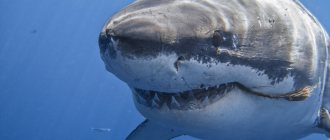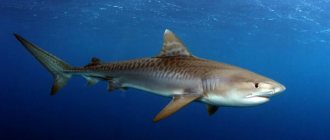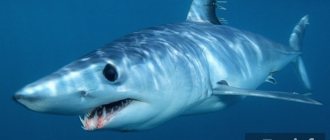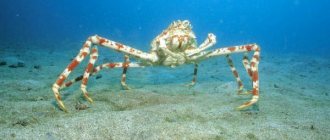Aren't all animals born alive? There can be no doubt about this obvious fact, but birth cannot always be called a live birth. In animals, there are 3 types of individual development of the organism, or ontogenesis - larval, oviparous and intrauterine.
Most bony fish have a larval type, but sharks are characterized by oviparity and intrauterine birth, that is, viviparity. In many species, development is something between oviparous and intrauterine development - ovoviviparity.
What is the difference between viviparity and ovoviviparity?
In placental viviparity, the fetus receives oxygen and nutrients from the mother's blood with the help of special organs - the placenta and umbilical cord. This is typical for all mammals except oviparous mammals - the platypus and echidna.
Viviparity in sharks is the only example of placental viviparity in cold-blooded vertebrates.
In ovoviviparity, eggs develop in the female's genital tract, but there is no direct contact and exchange of substances between the organisms of the mother and fetus. The cubs hatch from the egg shell in the posterior part of the mother's oviduct, and only after this they are born.
During their development, they feed mainly on the nutrients of the yolk sac. In sharks, feeding such embryos is possible in several other very specific ways (oophagy and the formation of royal jelly).
In addition to sharks, ovoviviparity is typical for species of lizards and snakes living in colder climates, some bony fish (swordtails, guppies, molynesias, gambusias), and certain species of toads. Reptiles do not have any additional devices for feeding; their embryos, during ovoviviparity, receive only water from the female genital tract.
Watch video - Embryonic oophagy in sharks:
Interesting facts about shark eggs
Shark eggs often have a very unusual shape and are called "mermaid's purse".
Oceanologists found a clutch in which all the eggs were placed in a shell resembling a bag, the cavity of which was filled with collagen mass. One shark egg can contain several embryos at the same time, but only one of them, the strongest, survives. Moreover, in the process of its development inside the egg, it eats its weaker brothers.
The size of a shark egg ranges from the size of a goose egg or a human palm to elongated spheres up to 2 meters long.
What are the features of viviparity in sharks?
At the beginning of development, embryos use the yolk, rich in high-calorie lecithin. Then part of the thin capsule of the egg and the wall of the already empty yolk sac form folds that tightly fit into the depressions in the wall of the uterus. Due to the formed folds, the surface area of contact between the organisms of the mother and the calf increases. This complex complex is called the placenta.
Through the placenta, all the substances necessary for growth and development enter the blood of the fetus: amino acids for the synthesis of proteins, sugars and fats as sources of energy and building material for cells.
In the opposite direction, toxic metabolic products pass into the female’s blood: ammonia, urea, carbon dioxide. A fairly long umbilical cord stretches from the placenta to the embryo, through the blood vessels of which blood moves in both directions.
What is the most dangerous shark for humans?
10 most dangerous sharks
- Blunt shark
or
bull
shark. - Great white shark
. - Tiger shark
. - The shark
is mako or blue-gray. Capable of reaching speeds of up to 60 km/h and jumping up to 6 meters above water. ... - Longtip shark
. ... - Gray reef shark
. ... - Hammerhead
shark. ... - Sand shark
.
What types of sharks are viviparous?
Placental viviparity occurs in 9% of all shark species: some hammerheads, some mustelids, and most carcharine sharks.
The American mustel shark gives birth to 10 to 20 young. The Cuban mustel shark, 30-40 cm long, usually develops 2 embryos in the uterus.
The longtip shark from the family of gray sharks gives birth to 5 to 7 sharks about 40 cm long.
Among hammerhead sharks, only some species have placental viviparity. Viviparous have 6 to 9 young, and ovoviviparous have 30-40, but all of them are born with the same proportions as adults and up to 50 cm in size.
Watch video - Embryo of a viviparous shark:
The shark and its role in the animal world of the planet
A shark is a fish that is an absolute predator. It serves as a kind of regulator not only of the number of inhabitants of the deep sea, but also as a nurse, since its victims, as a rule, are weak or sick individuals. In addition, it is the shark that serves as a stimulant for the improvement and self-development of those it eats. After all, wanting to protect themselves from predators, the inhabitants of the seas and oceans strive to improve their camouflage qualities, learn to develop greater speed of movement, that is, they evolve. And in order to regulate the shark population and preserve the population of its potential victims, nature has provided for the reproduction activity of both. And the shark is far from being in first place in this ranking - it reproduces much more slowly than other fish.
Reproduction
Unlike the bulk of fish, blunt-nosed sharks are viviparous. It should be noted that this is typical for most sharks.
The fertilized female carries the eggs in her body until they are fully mature. Females spend the entire summer giving birth. They gather in huge schools and give birth to baby sharks. One female gives birth to up to 10 babies. Immediately after giving birth, the female abandons the cubs, and is no longer interested in their fate. During the first days and months, small sharks live in the mouths of rivers, hiding from enemies.
When they are 4 years old, they reach sexual maturity and are ready to reproduce independently.
The lifespan of the blunt-nosed shark is about 30 years.
Is there shark caviar in the photo?
Yes, there are, and there are plenty of them on the Internet - many oviparous sharks are successfully kept and bred in captivity, so you can easily find their images and videos. But shark caviar is more correctly called shark eggs.
Photo: shark caviar are shark eggs
Since we already understood that sharks do not lay eggs, there are no photographs in nature that show the eggs laid by a shark. However, there are photos on the Internet that allegedly show collected shark caviar. Do not believe either these photographs or the “experts” themselves who claim that sharks lay eggs.
What interesting facts and myths about shark caviar do you know? Share your opinion in the comments!
How do sharks spawn?
I myself have often heard and read comments from people about shark eggs, even biology teachers who claim that sharks spawn eggs like other fish.
First, let's figure out what caviar is? A tasty thing to spread on a buttered sandwich on New Year's Eve and holidays, yes!
Well, from the point of view of an ichthyologist, these are fish eggs, as well as crustaceans, mollusks (octopuses, for example) and echinoderms (sea urchins). But they have significant differences from chicken eggs, for example. And also from the shark eggs themselves. These are essentially enlarged eggs, but they always have a spherical shape, do not have any shell and therefore are transparent and fragile.
To prevent the eggs from being damaged after they are laid by the female, they have the property of being sticky. After fertilization, many eggs develop a sticky shell and attach to bottom objects.
Sometimes such stickiness persists for a short period, and then the eggs peel off from the substrate and either complete their development in the water column (for example, in some Amur cyprinids), or roll up between the stones, as in some lithophilous fish spawning in river beds.
These are, first of all, salmon. The relatively large size of their eggs is associated with the presence of a large supply of yolk, which also applies to shark eggs. When a female fish has laid eggs, the male swims up to her and releases milt - a sexual product containing sperm, which in turn fertilize the eggs and develop inside the embryos until they hatch and become larvae.
It is as larvae that they swim with a yolk sac; when it resolves and their internal gills grow, they are already considered fry.
In some fish, eggs are contained inside the body (this also applies to shark eggs), and the whole process goes the same way, with the only difference being that the female herself swims in a cloud of the male’s milk and fertilization and development of the eggs takes place in the female’s body, and then gives birth.
Such species are called viviparous, although it is correct to call it ovoviviparous. A person who asks a question about shark eggs would probably like to see the process of how a shark lays eggs. But I will disappoint him - such a process - throwing eggs by a shark - does not exist in nature.
The video is not shark caviar, but real eggs:
LiveInternetLiveInternet
Baby sharks eat their relatives while still in the womb. The embryo of a sand tiger shark becomes a full-fledged predator already in the mother’s stomach.
The unborn baby sand tiger sharks have confirmed Darwin's stern principle of "survival of the fittest." Scientists made this conclusion based on a study: they observed 15 pregnant sharks, each of which had up to 9 “eggs.” The first cannibal baby that hatched ate the rest of its relatives. The sand tiger shark, or gray nurse shark, is a medium-sized shark, reaching 4 meters in length. Distributed in warm waters throughout the world's oceans, with the exception of the eastern Pacific Ocean. It is endangered. The shark's body is thick and wide, with two large fins on its back. Towards the head, the body narrows sharply, forming a sharp muzzle, the eyes are set close to the nose. The gill slits are not large. The back is gray or brown. The flat stomach is pale, almost white. The sandbar shark is a voracious predator that feeds on bony fish, other sharks, squid and bottom-dwelling mollusks. The sand shark is quite slow and clumsy, especially during the daytime. It usually lives in the intertidal zone near the bottom and is often found at shallow depths and in shallow waters. The shark got its name from its love of sandbanks. She is often seen close to the shore, on the beaches. In the surf zone, the shark slowly stalks its prey, which consists of small fish, squid, lobsters and crabs. She hunts after sunset. During the day, the fish is not active, preferring to sit out among the stones. At night, the shark has a monstrous appetite. Sometimes fish gather in small schools to hunt together. Cases of several sharks attacking nets full of fish have been recorded.
They do not have a swim bladder, and in order to stay afloat, they swallow large amounts of air. The sand tiger shark is the only shark that swallows air and holds it in its stomach to maintain buoyancy.
It reproduces by ovoviviparity, with the female giving birth to only one or two pups. The gray nurse shark has two queens. Each fertilized female produces several eggs. An interesting feature of this species is the so-called intrauterine ovophagy - the eating of eggs by embryos directly in the “uterus” of the mother, i.e. cannibalism from an early age. The number of eggs in the ovary (in sand sharks only the right ovary functions) reaches 24 thousand (their total mass reaches 2.5 kg) and in the posterior part (“uterus”) they are located in egg capsules, each of which contains about 20 eggs .
Young sharks hatch in their mother's womb, and in order to survive, the strongest young sharks need to devour their brothers in the stomach. Intrauterine nutrition of embryos begins quite early - at a length of 4-5 cm. Embryos with a length of 17 cm do not differ from adult fish in body shape and development of the dental apparatus. The baby shark has the same strong and sharp teeth, as well as a similar digestive system. Today, there are known cases where intrauterine sharks ate not only neighboring embryos, but even fully formed small sharks. A large amount of egg yolk was found in the stomachs of such embryos, and once they found an even smaller (4 cm long) embryo - a younger brother or sister.
Experts observed the pregnant female for a long time and eventually came to the conclusion that the intrauterine baby shark, which has reached a size of twenty centimeters, begins to move quite freely and actively in the amniotic fluid among the egg capsules that it has completely and partially eaten. At the end of pregnancy, there are about twenty to twenty-five small sharks in the belly of the female sand shark. Among them there is always one “dominant” one, developing faster than others, the strongest and most aggressive, which eats weaker sharks before birth (uterine cannibalism). Thus, by the end of the gestation period, the shark develops two babies - one in each uterus. To maintain their strength, the mother continues to produce eggs, which are used as food for the young cannibals. This process is called internal cannibalism and is widespread among all shark species. As a result, one, maximum two small sharks are born, reaching a length of about one meter at the time of birth.
There was also another interesting feature: in 60% of cases, both surviving cubs belonged to the same father. (The genetic diversity of each female's offspring suggested that the shark mated with multiple males.)
Scientists believe that embryonic cannibalism promotes faster and more active development of the eyes and teeth of the surviving cub. The results of the study were published in the journal Biology Letters. Thus, the primitive principle of survival and superiority over others of their own kind continues to exist even in such a cruel and exaggerated form. And, apparently, it’s not for nothing that we’re talking about sharks. Such reproduction, known in biology as “intrauterine cannibalism,” makes each baby shark very valuable for the future generation. Scientists plan to carry out artificial insemination of sexually mature females in order to maintain the population size of these interesting sharks. It is also believed that surgical removal of the hatchling and its subsequent artificial gestation can increase the number of sand tiger sharks. Sources: ,
Habitat
Our readers are probably wondering where the bull shark lives? It lives not only in salty seas, but also in freshwater lakes and rivers. It mainly lives in the waters off the coast of Latin and North America. In addition, this predator is found in the waters that wash India.
One species of bull shark (Gill & Bransford) lives permanently in Lake Nicaragua (Central America). It is connected to the Caribbean Sea by the rapids San Juan River, which is about 200 km long. The sharks that live there are the only known species adapted to live in fresh waters. The shark that lives in Lake Nicaragua is quite large - the average size is about 2.5 m, but there are individuals exceeding 3.5 meters in length or more.
The bull shark is found in the Panama Canal, where the waters of several lakes mix with the waters of two of the world's oceans. The appearance of predators has been noticed in Lake Izabal, Guatemala. Their appearance in the Atchafalaya River (Louisiana) is not uncommon.
According to unconfirmed reports, the gray bull shark, the photo of which is a special success for hunters, appears inland, in the channels cutting through southern and central Florida, but this claim requires further evidence.
In Southern China, India and other countries in the region, this shark is very feared and at the same time revered as sacred. Its rare species, which lives in the Ganges River, is accustomed to feasting on human flesh. Following local customs, the corpses of representatives of the upper castes are lowered into the waters of the Ganges, where terrible predators await them.
These are all marine mammals
A California sea lion sits on a rock off the reefs of La Jolla Beach. On land, the sea lion can rotate its hind flippers under the pelvic girdle, allowing it to support its weight and walk on all fours.
All these animals are marine mammals. They all give birth to live babies, produce milk, breathe through their lungs, and maintain a uniform body temperature.
- Dolphin
- sea otter
- Manatee
- Bloody
- Harbour porpoise
- Seal
- Sea lion
- WHALE
What does a giant shark eat?
Photo: Giant shark from the Red Book
The giant shark, despite its enormous size and wide mouth, has very tiny teeth. They are almost invisible against the background of the mouth, so the animal looks toothless. The shark's mouth is so large that it can swallow the average person whole. However, this predator is not at all interested in such large prey, so divers can even watch this fish in its natural environment at a safe distance.
The gastronomic preferences of the giant shark are quite meager. These animals are only interested in small animals, in particular plankton. Scientists often call the basking shark a passive filter or living net. This fish travels huge distances every day with its mouth open, thereby filling its stomach with plankton. This fish has a huge stomach. It can hold up to one ton of plankton. The shark seems to be filtering the water. In one hour, about two tons of water pass through its gills.
The basking shark needs a large amount of food for the normal functioning of its body. However, in the warm and cold seasons, the volume of food absorbed differs significantly. In summer and spring, fish eat about seven hundred calories in one hour, and in winter - only four hundred.
Appearance
The bull shark has a fairly large body. The size of the female (adult) sometimes exceeds 4 meters in length. Males are somewhat smaller - their body is approximately 2.5 meters long. This “fish” weighs more than 300 kilograms.
The bull shark, photos of which can be seen in publications about marine life, has a huge head with a blunt snout at the end. The scariest part of this animal is its jaws. These saw-shaped devices keep the entire underwater world at bay.
The body of the predator is painted gray. True, her belly is light, almost white, and her back is a richer tone. Depending on the lighting, the animal can change shade, becoming lighter or darker.
Why do people think sharks are mammals?
Some people think that because sharks give birth live, they automatically become mammals. They also confuse sharks with marine mammals such as dolphins, porpoises and killer whales. Sharks have a similar body shape to these mammals and are roughly the same size.
The confusion is understandable because sharks and marine mammals share some characteristics.
A shark is a fish. Instead of a skeleton, a shark has hard, flexible cartilage, less dense than bone. A shark does not breathe with its lungs. It breathes by taking in oxygen through its gills.
Behavior in nature
Experts consider the males of these sharks to be the most aggressive. If the prey comes into the sight of toothy predators, it has no chance of escape. The bull shark is distinguished by its enormous strength and incredible speed. She is able to overtake the victim in a matter of seconds. At the same time, she attacks immediately, leaving no opportunity to escape from her terrible mouth.
According to scientists, the particularly aggressive behavior of males is based on the fact that their body produces large amounts of testosterone, the male hormone that is responsible for the aggression of all life on Earth. This is confirmed by practical observations and research - subject to seemingly unreasonable outbursts of rage, bull sharks rush at everything that moves - even the propeller of a boat motor.
The muzzle of these predators has a blunt, flattened shape, which increases their maneuverability, and a mouth full of sharp and jagged teeth is a very formidable weapon. Baby sharks are born with a huge number of teeth. If one of the teeth in the front row falls out, a new one does not grow, and its place is taken by the one in the back row. This series is constantly growing, replenishing the jaws of predators with new terrible weapons.
The bull shark is an extremely fast and strong animal. There is no escape from her grasp! She torments the victim, not paying any attention to the pain and blows inflicted.
The behavior of bull sharks is impossible to predict. They can swim nearby quite calmly for a long time, and then suddenly attack a person.
These predators very jealously guard their possessions - an alien who accidentally or deliberately invades will most definitely be destroyed.
Is there whale shark caviar?
Almost nothing is known about how the whale shark, the largest of all fish on the planet, reproduces, although this species has been observed for more than a hundred years. Therefore, the most interesting question about this predator is whether the whale shark has caviar?
Until very recently, information was very scarce and scattered. It is known that the whale shark is ovoviviparous and does not spawn - the embryos develop in capsule eggs, hatching from them in the womb, after which the shark gives birth to them. Although previously scientists assumed that this fish lays eggs.
Photo: whale shark egg capsule
Population and species status
Photo: Giant shark
Basking sharks are unique, huge fish that are one of the largest sources of squalene. One animal can produce about two thousand liters! Also, the meat of these sharks is edible. In addition, people eat fins. They make an excellent soup. And the skin, cartilage, and other parts of fish are used in folk medicine. However, today there is no fishing for these fish in almost the entire natural range.
Sharks of this species practically do not harm humans. They do not attack people, as they prefer to feed only on plankton. You can even touch a basking shark with your hand, but you should be careful because you can get hurt by the placoid scales. Their only harm is to ram small fishing vessels. Perhaps the fish perceive them as a shark of the opposite sex. The lack of official fishing is associated with the gradual extinction of the species. The number of basking sharks is decreasing. These fish were given the conservation status: “Vulnerable”.
The population of basking sharks has declined significantly, so the animals have been given more than just characteristic conservation status. These sharks were included in the International Red Book, and a number of states have developed special measures for their protection.











